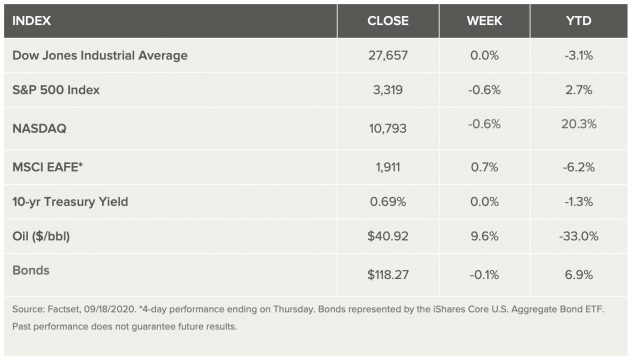
Stock Markets
U.S. stocks closed at a six-week low, driven by weakness in technology stocks, which exert an outsized influence on major indexes because of their size. Even though more than 70% of the S&P 500 stocks were higher, the index closed lower for the third week in a row. On the flip side, cyclical, small-cap and international stocks, and oil, all rebounded, finishing positive for the week. The Federal Reserve signaled that it will keep rates near zero through at least 2023 to help the economy weather the health and economic crisis. Economic data showed that the economic recovery is progressing, but the pace of improvement is slowing. In this environment, analysts believe, as last week demonstrated, that well-diversified portfolios can be better prepared to weather volatility.
US Economy
Fall officially ousts summer this week, ushering in traditional seasonal changes (back to school, weather, holidays, etc.) that may pose particular implications for economic conditions over the remainder of the year given the unique environment. Fresh economic readings, politics and the latest Fed meeting were all on stage last week, highlighting three key market matchups that will shape the investment landscape as we advance through 2020.
History shows that over time market performance is driven principally by fundamentals, not elections. Trends in economic conditions, corporate profits and interest rates have been the more powerful and lasting guide for investment values. Analysts contend that the combination of a sustained but gradual economic expansion, a rebound in corporate profits, and an ongoing monetary-policy stimulus – though not immune to presidential policies – will set the broader course for the markets regardless of the election outcome.
Metals and Mining
Gold faced some headwinds this session, leaving gains muted, but poor data paired with a pressured US dollar helped the yellow metal rally late in the week. The other precious metals are on track to end the week in the red; meanwhile, the base metals sector has faced similar challenges, prohibiting the space from locking in gains. After slipping to US$1,938.50 per ounce on — a three-week low — the yellow metal was climbing back towards US$1,950 on Friday. Reports that US jobless claims topped 30 million in August bolstered the metal’s appeal late in the week. Silver’s performance this week was also punctuated by volatility. The white metal trended higher from mid-August until September 11, but then shed some 2 percent and fell to US$26.64 per ounce. This week, silver spiked back above US$27 on Tuesday before dipping back to US$26.52. Analysts see more price growth ahead for silver. Silver was priced at US$26.89 as Friday. Platinum was on track to end the week in the red after prices broke a three-week high, hitting US$968 per ounce before plummeting as low as US$920. An uneven recovery in China’s auto sector is credited with the dip in platinum prices, while the same industry is responsible for palladium’s recent price surge. Despite the recent volatility, platinum is in its pre-pandemic range, but still shy of its year-to-date high of US$1,022. Platinum was moving for US$924 on Friday. As mentioned, palladium prices have been supported by China’s recovering automotive manufacturers. On Monday the autocatalyst metal was selling for US$2,206; a mid-week surge took prices north of US$2,289 before pressure sent the metal lower By Friday, an ounce of palladium was valued at US$2,213.
Copper hit a two year high this week of US$6,813 per tonne. However, the metal’s gain was short-lived, and it fell below US$6,800 shortly after. During a digital event held by Euromoney’s Global Investor Group, panelists discussed the potential for a commodities super cycle coming out of COVID-19. While experts were hesitant to say that will happen, they did note that copper and nickel could see significant upticks as a result of automation, electric vehicles (EVs) and robotics. Nickel shed some of the gains it made early in the week, slipping from US$15,090 per tonne on Monday to US$14,895 by Friday. Zinc also made strides mid-session, climbing to US$2,505 per tonne. It’s expected that prices for the both zinc and lead could spike in the weeks to come due to news that base metals producer Central Asia Metals will curtail production due to a tailings dam leak. The shutdown will cut some 400 to 500 tonnes per week of zinc-in-concentrate and another 500 to 600 tonnes per week of lead-in-concentrate. The shutdown comes as the Chinese economy continues to recover from COVID-19-mandated lockdowns. On Friday morning, zinc was priced at US$2,454.50. Lead was valued at US$1,858 per tonne, a slight dip from Monday’s US$1,873.50.
Energy and Oil
Oil rebounded above $40 at the end of the week after EIA data showed a drawdown in oil storage and Hurricane Sally forced offshore platforms offline. Oil gained more ground after the Saudi oil minister warned speculators gambling in the market. To short-sellers betting on a slide in prices, he said: “Make my day.” He added that OPEC+ will actively and pre-emptively manage the market. The group also pressured laggards to increase their compliance. Goldman Sachs sees Brent rising to $49 per barrel before the end of the year. “We estimate that the oil market remains in deficit with speculative positioning now at too low levels,” Goldman Sachs said.
Democratic Presidential candidate Joe Biden once again reiterated support for fracking in a CNN town hall event in Pennsylvania on Thursday. “Fracking has to continue because we need a transition,” Biden said. “We’re going to get to net-zero emissions by 2050, and we’ll get to net-zero power emissions by 2035. But there’s no rationale to eliminate, right now, fracking.”
Natural gas spot prices fell at most locations this week. The Henry Hub spot price fell from $2.19 per million British thermal units (MMBtu) last week to $2.06/MMBtu this week. At the New York Mercantile Exchange (Nymex), the price of the October 2020 contract decreased 14¢, from $2.406/MMBtu last week to $2.267/MMBtu this week. The price of the 12-month strip averaging October 2020 through September 2021 futures contracts declined 8¢/MMBtu to $2.880/MMBtu.
World Markets
The pan-European STOXX Europe 600 Index overcame concerns about a resurgence in the number of coronavirus cases to eke out a 0.22% gain. However, the major European indexes lost ground: Germany’s Xetra DAX Index slipped 0.66%, Italy’s FTSE MIB tumbled 1.49%, France’s CAC 40 pulled back 1.11%, and the UK’s FTSE 100 Index gave up 0.42%.
The STOXX Europe 50, STOXX Europe 600, FTSE 100, DAX, and Spain’s IBEX were set to rebalance on Friday, with additions and deletions going into effect after the European close.
Hans Kluge, the World Health Organization’s European director, warned that Europe was facing a “very serious” situation as the number of new coronavirus cases reported weekly in Europe hit 300,000 for the first time. Kluge noted that in the past two weeks, more than half of European countries had registered a greater than 10% increase in coronavirus infections. He advised against “even a slight reduction in the length of the quarantine.”
Chinese stocks rallied as a batch of indicators highlighted the country’s economic momentum, and investors hoped for more fiscal stimulus to boost the coronavirus-hit economy. The benchmark Shanghai Composite Index and blue-chip CSI 300 Index each rose 2.4% for the week after two straight weeks of losses. In fixed income markets, the yield on China’s sovereign 10-year bond was broadly flat for the week as of Friday morning despite signs of the improving economy. The yuan strengthened against the U.S. dollar for the eighth consecutive week.
A trio of economic readings offered more evidence of a strong recovery unfolding in China, the first country to successfully control the coronavirus. Retail sales rose 0.5% in August from a year ago, the first year-over-year growth since the pandemic began. Industrial production, seen as the best proxy for gross domestic product, rose a better-than-expected 5.6% in August from a year earlier. Fixed-asset investment in the first eight months of 2020 declined slightly from a year ago, narrowing the 1.6% decline from January to July and in line with forecasts.
The Week Ahead
Economic data being released include existing home sales on Tuesday, the September preliminary Purchasing Managers’ Index on Wednesday, and durable goods orders on Friday.
Key Topics to Watch
- Chicago national activity index
- Household debt (SAAR)
- Existing home sales (SAAR)
- Markit manufacturing PMI
- Markit services PMI
- Initial jobless claims (regular state program, SA)
- Initial jobless claims (federal & state, NSA)
- Continuing jobless claims (regular state program, SA)
- Continuing jobless claims (federal & state, NSA)
- New home sales (SAAR)
- Durable goods orders
- Core capital goods orders
Market Summary
























